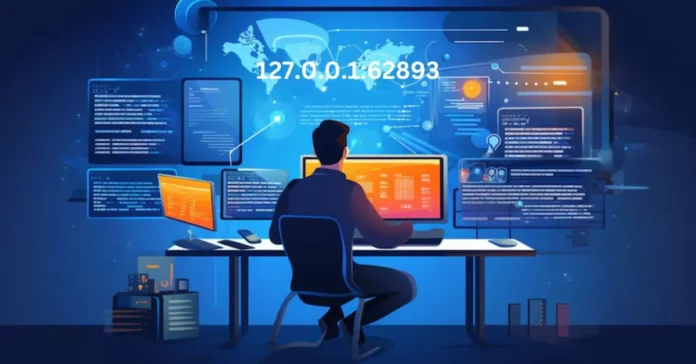127.0.0.1:62893 – What Does It Mean? And How to Fix Errors? (Easy Guide)

Have you ever encountered the code “127.0.0.1:62893” while working on your computer? It might look confusing at first glance, but don’t worry! This article will break down everything you need to know about this code, what it means, and how to fix any errors you might encounter with it.
By the end of this guide, you’ll have a clear understanding of:
- What the different parts of the code (127.0.0.1 and 62893) mean.
- Why you might see this code.
- How to troubleshoot common errors related to 127.0.0.1:62893.
So, whether you’re a tech wiz or just starting out, this guide is for you! Let’s dive in.
Understanding the Code: 127.0.0.1 and 62893
The code “127.0.0.1:62893” actually consists of two separate parts:
-
127.0.0.1: This is a special IP address called localhost. Think of an IP address as a unique online address for a device, just like your house has a unique address. But localhost is a bit different. It’s a special address that refers back to your own computer, like a loopback address that points inward. It’s a way for programs on your computer to talk to each other internally, without going out to the big wide internet.
-
62893: This is a port number. Imagine your computer is a big apartment building. Different programs running on your computer are like different apartments. Ports are like doorways for these programs to send and receive information. Each port has a specific number, so data doesn’t get mixed up. The number 62893 is not as common as some others, but it’s sometimes used by a program called Memcached, which helps store information to make things run faster.
So, when you see 127.0.0.1:62893 together, it usually means that a program on your computer is trying to connect to something running on your own computer (localhost) at port number 62893. This is often used for development purposes or by certain applications.
Why You Might See This Code
There are a few reasons why you might encounter the code 127.0.0.1:62893:
-
Using Development Tools: If you’re working with developer tools or software that allows you to test applications on your local machine (your own computer), you might see this code when the program tries to connect to its own internal services running on localhost.
-
Error Messages: Sometimes, if an application is trying to connect to something on port 62893 on localhost but can’t for some reason, you might see an error message that includes this code. This could be because the service isn’t running, there’s a firewall blocking the connection, or there’s another issue.
-
Information Purposes: In some cases, you might just see this code displayed for informational purposes. For example, some programs might show you the address they’re connected to, and if it’s running on localhost, it might display 127.0.0.1:62893.
Troubleshooting Errors Related to 127.0.0.1:62893
If you’re encountering an error message that includes 127.0.0.1:62893, here are some steps you can take to troubleshoot the issue:
-
Identify the Program: First, try to figure out which program is causing the error. You might see the name of the program in the error message itself, or you might need to do some research based on the context in which you saw the error.
-
Is the Service Running? If the program uses Memcached (which sometimes uses port 62893), check if the Memcached service is actually running on your computer. There might be a way to start or restart the service from the program’s settings or through your operating system’s tools. You can find instructions specific to your operating system with a quick web search.
-
Firewall Settings (Continued): You might need to temporarily disable your firewall (be cautious while doing this!) to see if that resolves the issue. If it does, you’ll need to configure your firewall to allow connections on port 62893 for the specific program that’s causing the error. Always consult your firewall documentation or seek help online for adding specific programs to your firewall’s allowed list.
-
Conflicting Applications: In rare cases, another program on your computer might be using port 62893, which could cause conflicts. Try closing any unnecessary applications that might be using this port.
-
Reinstall or Update Software: If the error persists, consider reinstalling or updating the program that’s causing the issue. Sometimes bugs in the software can lead to connection problems. Check the program’s website for updates or reinstalling instructions.
-
Seek Help from the Software Developer: If you’ve tried all of the above steps and are still having trouble, you might need to seek help from the developer of the program that’s causing the error. They might have specific troubleshooting tips or know about known issues related to port 62893.
Additional Tips
Here are some additional tips to keep in mind:
- Be Cautious with Firewall Changes: Remember, disabling your firewall can make your computer more vulnerable to security threats. Only disable it temporarily for troubleshooting purposes and make sure to re-enable it afterwards.
- Don’t Edit System Files: Unless you’re comfortable with advanced troubleshooting, avoid editing system files or configurations related to ports. This could lead to more serious problems.
- Back Up Your Data: Before making any major changes to your system, it’s always a good idea to back up your important data. This way, if something goes wrong, you can easily restore your files.
Conclusion
By understanding what the code 127.0.0.1:62893 means and following the troubleshooting steps in this guide, you should be able to resolve most errors related to it. Remember, if you’re unsure about any step, it’s always best to consult a tech-savvy friend or seek help from a professional.
We hope this guide has been helpful! If you have any further questions, feel free to leave a comment below.
-




